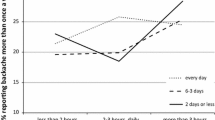Abstract
Background
Sedentary leisure time might be affecting children’s and adolescents’ general health. We investigated the association between watching television and computer use in this age group and psychosomatic health complaints.
Methods
This study of 14,274 students aged 7–18 years was conducted in Iran between 2014 and 2015, as part of the fifth school-based nationwide health survey named the childhood and adolescence surveillance and prevention of adult non-communicable disease (CASPIAN-V) study. In addition to gathering data on time spent watching television or using a computer per day, we categorized the health complaints into somatic (headache, backache, stomach ache, and feeling dizzy) and psychological (feeling low, feeling nervous, irritability, and difficulty falling asleep) symptoms. Regression models were used to determine the relationships between variables.
Results
All psychological health complaints, as well as headaches, were significantly more prevalent in the over-14 age group, both in girls and boys. Lower socioeconomic status, living in families where one or two parents were absent, and living in urban areas were all associated with higher psychosomatic health problems. Also, more time spent watching television was associated with more stomach aches and irritability (OR = 1.12 and 1.14 respectively). More time spent using a computer correlated with a higher prevalence of stomach aches, irritability, feeling nervous, and difficulty falling asleep (OR = 1.15, 1.12, 1.29, and 1.07 respectively).
Conclusion
Prolonged time spent on television watching or computer use might be associated with adverse effects on children’s and adolescents’ psychosomatic health status.

Similar content being viewed by others
References
Andrade Neto F, Eto FN, Pereira TS, Carletti L, Molina Mdel C (2014) Active and sedentary behaviours in children aged 7 to 10 years old: the urban and rural contexts, Brazil. BMC Public Health 14:1174. https://doi.org/10.1186/1471-2458-14-1174
Biddle SJ, Asare M (2011) Physical activity and mental health in children and adolescents: a review of reviews. Br J Sports Med 45:886–895. https://doi.org/10.1136/bjsports-2011-090185
Brindova D, Veselska ZD, Klein D, Hamrik Z, Sigmundova D, van Dijk JP, Reijneveld SA, Geckova AM (2015) Is the association between screen-based behaviour and health complaints among adolescents moderated by physical activity? Int J Public Health 60:139–145. https://doi.org/10.1007/s00038-014-0627-x
Brink Y, Louw QA (2013) A systematic review of the relationship between sitting and upper quadrant musculoskeletal pain in children and adolescents. Man Ther 18:281–288. https://doi.org/10.1016/j.math.2012.11.003
Cao H, Qian Q, Weng T, Yuan C, Sun Y, Wang H, Tao F (2011) Screen time, physical activity and mental health among urban adolescents in China. Prev Med 53:316–320. https://doi.org/10.1016/j.ypmed.2011.09.002
Carlerby H, Viitasara E, Knutsson A, Gillander Gadin K (2011) Subjective health complaints among boys and girls in the Swedish HBSC study: focussing on parental foreign background. Int J Public Health 56:457–464. https://doi.org/10.1007/s00038-011-0246-8
Costigan SA, Barnett L, Plotnikoff RC, Lubans DR (2013) The health indicators associated with screen-based sedentary behavior among adolescent girls: a systematic review. J Adolesc Health 52:382–392. https://doi.org/10.1016/j.jadohealth.2012.07.018
Dey M, Jorm AF, Mackinnon AJ (2015) Cross-sectional time trends in psychological and somatic health complaints among adolescents: a structural equation modelling analysis of ‘Health behaviour in school-aged children’ data from Switzerland. Soc Psychiatry Psychiatr Epidemiol 50:1189–1198. https://doi.org/10.1007/s00127-015-1040-3
Fakhouri TI, Hughes JP, Brody DJ, Kit BK, Ogden CL (2013) Physical activity and screen-time viewing among elementary school-aged children in the United States from 2009 to 2010. JAMA Pediatr 167:223–229. https://doi.org/10.1001/2013.jamapediatrics.122
Goon DT, Nsibambi CA, Chebet M (2016) Time spent in sedentary activities in a pediatric population in Pretoria Central, South Africa. S Afr Minerva Pediatr 68:435–440
Hale L, Guan S (2015) Screen time and sleep among school-aged children and adolescents: a systematic literature review. Sleep Med Rev 21:50–58. https://doi.org/10.1016/j.smrv.2014.07.007
Hamrik Z, Bobakova D, Kalman M, Veselska ZD, Klein D, Geckova AM (2015) Physical activity and screen-based activity in healthy development of school-aged children. Cent Eur J Public Health 23(Suppl):S50–S56. https://doi.org/10.21101/cejph.a4188
Hovsepian S, Kelishadi R, Motlagh ME, Kasaeian A, Shafiee G, Arefirad T, Najafi F, Khoramdad M, Asayesh H, Heshmat R, Qorbani M (2016) Level of physical activity and screen time among Iranian children and adolescents at the national and provincial level: the CASPIAN-IV study. Med J Islam Repub Iran 30:422
Husarova D, Veselska ZD, Sigmundova D, Geckova AM (2015) Age and gender differences in prevalence of screen based behaviour, physical activity and health complaints among Slovak school-aged children. Cent Eur J Public Health 23(Suppl):S30–S36. https://doi.org/10.21101/cejph.a4177
Jari M, Qorbani M, Motlagh ME, Heshmat R, Ardalan G, Kelishadi R (2014) A nationwide survey on the daily screen time of Iranian children and adolescents: the CASPIAN-IV study. Int J Prev Med 5:224–229
Jorn H, Torbjorn T, Leif EA (2002) Subjective health complaints in adolescence: dimensional structure and variation across gender and age. Scand J Public Health 30:223–230. https://doi.org/10.1177/140349480203000309
Keane E, Kelly C, Molcho M, Nic Gabhainn S (2017) Physical activity, screen time and the risk of subjective health complaints in school-aged children. Prev Med 96:21–27. https://doi.org/10.1016/j.ypmed.2016.12.011
Kelishadi R, Ardalan G, Qorbani M, Ataie-Jafari A, Bahreynian M, Taslimi M, Motlagh ME, Heshmat R (2013) Methodology and early findings of the fourth survey of childhood and adolescence surveillance and prevention of adult non-communicable disease in Iran: the CASPIAN-IV study. Int J Prev Med 4:1451–1460
Kelishadi R, Qorbani M, Motlagh ME, Heshmat R, Ardalan G, Jari M (2015) Relationship between leisure time screen activity and aggressive and violent behaviour in Iranian children and adolescents: the CASPIAN-IV study. Paediatr Int Child Health 35:305–311. https://doi.org/10.1080/20469047.2015.1109221
Kremer P, Elshaug C, Leslie E, Toumbourou JW, Patton GC, Williams J (2014) Physical activity, leisure-time screen use and depression among children and young adolescents. J Sci Med Sport 17:183–187. https://doi.org/10.1016/j.jsams.2013.03.012
Lacy KE, Allender SE, Kremer PJ, de Silva-Sanigorski AM, Millar LM, Moodie ML, Mathews LB, Malakellis M, Swinburn BA (2012) Screen time and physical activity behaviours are associated with health-related quality of life in Australian adolescents. Qual Life Res 21(6):1085–1099. https://doi.org/10.1007/s11136-011-0014-5
Lauricella A, Wartella E, Rideout VJ (2015) Young children's screen time: the complex role of parent and child factors. J Appl Dev Psychol 36:11. https://doi.org/10.1016/j.appdev.2014.12.001
LeBlanc AG, Broyles ST, Chaput JP, Leduc G, Boyer C, Borghese MM, Tremblay MS (2015a) Correlates of objectively measured sedentary time and self-reported screen time in Canadian children. Int J Behav Nutr Phys Act 12:38. https://doi.org/10.1186/s12966-015-0197-1
LeBlanc AG, Katzmarzyk PT, Barreira TV, Broyles ST, Chaput JP, Church TS, Fogelholm M, Harrington DM, Hu G, Kuriyan R, Kurpad A, Lambert EV, Maher C, Maia J, Matsudo V, Olds T, Onywera V, Sarmiento OL, Standage M, Tudor-Locke C, Zhao P, Tremblay MS (2015b) Correlates of total sedentary time and screen time in 9–11 year-old children around the world: the international study of childhood obesity, lifestyle and the environment. PLoS One 10:e0129622. https://doi.org/10.1371/journal.pone.0129622
Maras D, Flament MF, Murray M, Buchholz A, Henderson KA, Obeid N, Goldfield GS (2015) Screen time is associated with depression and anxiety in Canadian youth. Prev Med 73:133–138. https://doi.org/10.1016/j.ypmed.2015.01.029
Marques A, Calmeiro L, Loureiro N, Frasquilho D, de Matos MG (2015) Health complaints among adolescents: associations with more screen-based behaviours and less physical activity. J Adolesc 44:150–157. https://doi.org/10.1016/j.adolescence.2015.07.018
Mendes AV, Souza Crippa JA, Souza RM, Loureiro SR (2013) Risk factors for mental health problems in school-age children from a community sample. Matern Child Health J 17:1825–1834. https://doi.org/10.1007/s10995-012-1202-9
Nakamura H, Ohara K, Kouda K, Fujita Y, Mase T, Miyawaki C, Okita Y, Ishikawa T (2012) Combined influence of media use on subjective health in elementary school children in Japan: a population-based study. BMC Public Health 12:432. https://doi.org/10.1186/1471-2458-12-432
Nuutinen T, Roos E, Ray C, Villberg J, Valimaa R, Rasmussen M, Holstein B, Godeau E, Beck F, Leger D, Tynjala J (2014) Computer use, sleep duration and health symptoms: a cross-sectional study of 15-year olds in three countries. Int J Public Health 59:619–628. https://doi.org/10.1007/s00038-014-0561-y
Ottová-Jordan V, Smith ORF, Augustine L, Gobina I, Rathmann K, Torsheim T, Mazur J, Välimaa R, Cavallo F, Jericek Klanscek H, Vollebergh W, Meilstrup C, Richter M, Moor I, Ravens-Sieberer U (2015) Trends in health complaints from 2002 to 2010 in 34 countries and their association with health behaviours and social context factors at individual and macro-level. Eur J Pub Health 25:83–89. https://doi.org/10.1093/eurpub/ckv033
Primack BA, Swanier B, Georgiopoulos AM, Land SR, Fine MJ (2009) Association between media use in adolescence and depression in young adulthood: a longitudinal study. Arch Gen Psychiatry 66:181–188. https://doi.org/10.1001/archgenpsychiatry.2008.532
Saunders TJ, Vallance JK (2017) Screen time and health indicators among children and youth: current evidence, limitations and future directions. Appl Health Econ Health Policy 15:323–331. https://doi.org/10.1007/s40258-016-0289-3
Sund AM, Larsson B, Wichstrøm L (2011) Role of physical and sedentary activities in the development of depressive symptoms in early adolescence. Soc Psychiatry Psychiatr Epidemiol 46:431–441. https://doi.org/10.1007/s00127-010-0208-0
Torsheim T, Eriksson L, Schnohr CW, Hansen F, Bjarnason T, Välimaa R (2010) Screen-based activities and physical complaints among adolescents from the Nordic countries. BMC Public Health 10:324. https://doi.org/10.1186/1471-2458-10-324
Veldhuis L, van Grieken A, Renders CM, Hirasing RA, Raat H (2014) Parenting style, the home environment, and screen time of 5-year-old children; the ‘be active, eat right’ study. PLoS One 9:e88486. https://doi.org/10.1371/journal.pone.0088486
Acknowledgments
We want to thank the large team working on this project as well as all study participants.
Funding
This study was funded by Isfahan University of Medical Sciences, Isfahan, Iran (Project No. 194049).
Author information
Authors and Affiliations
Contributions
RF contributed in the conception of the work, manuscript preparation, manuscript revision, and final approval of the manuscript, and agreed to be accountable for all aspects of the work.
ZA contributed in study design, data acquisition, manuscript revision, and final approval of the manuscript, and agreed to be accountable for all aspects of the work.
RH contributed in the conception of the work, study design, interpretation of data, manuscript revision, and final approval of the manuscript, and agreed to be accountable for all aspects of the work.
MEM contributed in study design, data acquisition, manuscript revision, and final approval of the manuscript, and agreed to be accountable for all aspects of the work.
AS contributed in statistical analysis, interpretation of data, manuscript revision, and final approval of the manuscript, and agreed to be accountable for all aspects of the work.
HZ contributed in study design, data acquisition, manuscript revision, and final approval of the manuscript, and agreed to be accountable for all aspects of the work.
MT contributed in the conception of the work, data acquisition, manuscript revision, and final approval of the manuscript, and agreed to be accountable for all aspects of the work.
MQ contributed in statistical analysis, interpretation of data, manuscript revision, and final approval of the manuscript, and agreed to be accountable for all aspects of the work.
SBM contributed in the conception of the work, manuscript preparation, manuscript revision, and final approval of the manuscript, and agreed to be accountable for all aspects of the work.
RK contributed in the conception of the work, study design, manuscript revision, and final approval of the manuscript, and agreed to be accountable for all aspects of the work.
Corresponding authors
Ethics declarations
Conflict of interest
The authors declare that they have no conflict of interest.
Ethical approval
All procedures performed in studies involving human participants were in accordance with the ethical standards of the institutional and/or national research committee and with the 1964 Helsinki declaration and its later amendments or comparable ethical standards.
Informed consent
Informed consent was obtained from all individual participants included in the study.
Additional information
Publisher’s note
Springer Nature remains neutral with regard to jurisdictional claims in published maps and institutional affiliations.
Rights and permissions
About this article
Cite this article
Faridizad, R., Ahadi, Z., Heshmat, R. et al. Association of screen time with subjective health complaints in Iranian school-aged children and adolescents: the CASPIAN-V study. J Public Health (Berl.) 28, 31–40 (2020). https://doi.org/10.1007/s10389-019-01014-2
Received:
Accepted:
Published:
Issue Date:
DOI: https://doi.org/10.1007/s10389-019-01014-2




